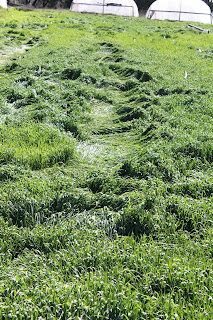More precisely, this is called anthesis, a noun of action based on the Greek word for flower (anthos). What it means is that the buds are opening as flowers, going through the fun of getting self-pollinated, and starting to become the fruit – those wheat berries we’ve been waiting for. On average, we would expect these seed heads to be fully mature in five weeks, changing from green to golden tan, and becoming crunchy. It can happen sooner if the weather turns hot.


Our GLENN plot does have a wide range of likely maturity, which means we may be harvesting over a couple of week’s time. Or more. As various portions of the field reach maturity, we’ll only be able to give a day’s notice before a few willing hands will be needed to cut and bag the grain from that part of the wheat that is fully ripe.
We’ve also have impressive progress in our test bed.
 |
| Northern half of Test Plot |
India-Jammu is the tallest, at more than 31”, with many emerging seed heads. Clear White is about 24” and has the most seed heads fully emerged. It is a short-stature hard white spring common wheat with an early season heading time and good resistance to shattering and lodging. Clear White was developed at UC Davis and released in 2005.
 |
| India-Jammu |
 |
| Clear White |
 |
| Louise |
The spelt has suffered a bit of a set-back, with substantial areas of our Maverick plot flattened. (It is not certain why.)


The portions that remain standing seem to be doing well, but they are likely to be maturing in late May or early June.
The second planting of Sonora continues to recover from its partial collapse in February. It still looks as though it will be our second crop to harvest ... after our two plots of Glenn.











































